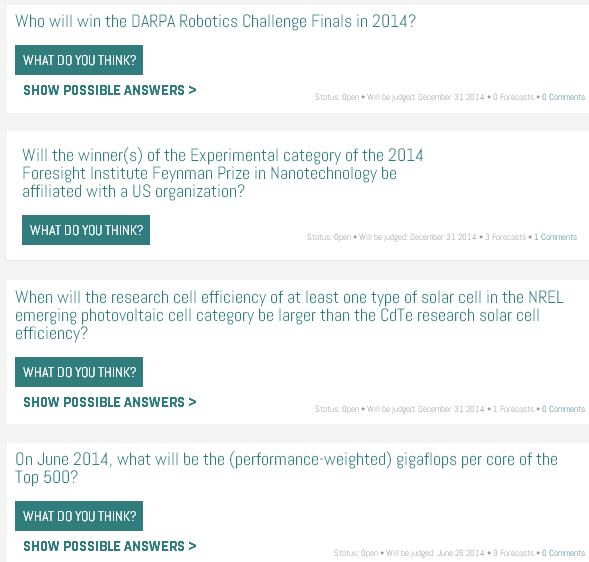Crowdsourcing forecasts on science and technology events and innovations
January 10, 2014
George Mason University launched today, Jan. 10, the largest and most advanced science and technology prediction market in the world: SciCast.
The federally funded research project aims to improve the accuracy of science and technology forecasts. George Mason research assistant professor Charles Twardy is the principal investigator of the project.
SciCast crowdsources forecasts on science and technology events and innovations from aerospace to zoology.
For example, will Amazon use drones for commercial package delivery by the end of 2017? Today, SciCast estimates the chance at slightly more than 50 percent. If you think that is too low, you can estimate a higher chance. SciCast will use your estimate to adjust the combined forecast.
Forecasters can update their forecasts at any time; in the above example, perhaps after the Federal Aviation Administration (FAA) releases its new guidelines for drones. The continually updated and reshaped information helps both the public and private sectors better monitor developments in a variety of industries. SciCast is a real-time indicator of what participants think is going to happen in the future.
“Combinatorial” prediction market better than simple average
The idea is that collective wisdom from diverse, informed opinions can provide more accurate predictions than individual forecasters, a notion borne out by other crowdsourcing projects. Simply taking an average is almost always better than going with the “best” expert. But in a two-year test on geopolitical questions, the SciCast method did 40 percent better than the simple average.
SciCast uses the first general “combinatorial” prediction market. In a prediction market, forecasters spend points to adjust the group forecast. Significant changes “cost” more — but “pay” more if they turn out to be right. So better forecasters gain more points and therefore more influence, improving the accuracy of the system.
In a combinatorial market like SciCast, forecasts can influence each other. For example, forecasters might have linked cherry production to honeybee populations. Then, if forecasters increase the estimated percentage of honeybee colonies lost this winter, SciCast automatically reduces the estimated 2014 cherry production. This connectivity among questions makes SciCast more sophisticated than other prediction markets.
SciCast topics include agriculture, biology and medicine, chemistry, computational sciences, energy, engineered technologies, global change, information systems, mathematics, physics, science and technology business, social sciences, space sciences and transportation.
Seeking futurists to improve forecasts, pose questions
“With so many science and technology questions, there are many niches,” says Twardy, a researcher in the Center of Excellence in Command, Control, Communications, Computing and Intelligence (C4I), based in Mason’s Volgenau School of Engineering.
“We seek scientists, statisticians, engineers, entrepreneurs, policymakers, technical traders, and futurists of all stripes to improve our forecasts, link questions together and pose new questions.”
Forecasters discuss the questions, and that discussion can lead to new, related questions. For example, someone asked,Will Amazon deliver its first package using an unmanned aerial vehicle by Dec. 31, 2017?
An early forecaster suggested that this technology is likely to first be used in a mid-sized town with fewer obstructions or local regulatory issues. Another replied that Amazon is more likely to use robots to deliver packages within a short radius of a conventional delivery vehicle. A third offered information about an FAA report related to the subject.
Any forecaster could then write a question about upcoming FAA rulings, and link that question to the Amazon drones question. Forecasters could then adjust the strength of the link.
“George Mason University has succeeded in launching the world’s largest forecasting tournament for science and technology,” says Jason Matheny, program manager of Forecasting Science and Technology at the Intelligence Advanced Research Projects Activity, based in Washington, D.C. “SciCast can help the public and private sectors to better understand a range of scientific and technological trends.”
Collaborative but Competitive
More than 1,000 experts and enthusiasts from science and tech-related associations, universities and interest groups preregistered to participate in SciCast. The group is collaborative in spirit but also competitive. Participants are rewarded for accurate predictions by moving up on the site leaderboard, receiving more points to spend influencing subsequent prognostications. Participants can (and should) continually update their predictions as new information is presented.
SciCast has partnered with the American Association for the Advancement of Science, the Institute of Electrical and Electronics Engineers, and multiple other science and technology professional societies.
Mason members of the SciCast project team include Twardy; Kathryn Laskey, associate director for the C4I and a professor in the Department of Systems Engineering and Operations Research; associate professor of economics Robin Hanson; C4I research professor Tod Levitt; and C4I research assistant professors Anamaria Berea, Kenneth Olson and Wei Sun.
To register for SciCast, visit www.SciCast.org, or for more information, e-mail [email protected]. SciCast is open to anyone age 18 or older.
KurzweilAI is exploring a collaboration with the SciCast team. — Editor


